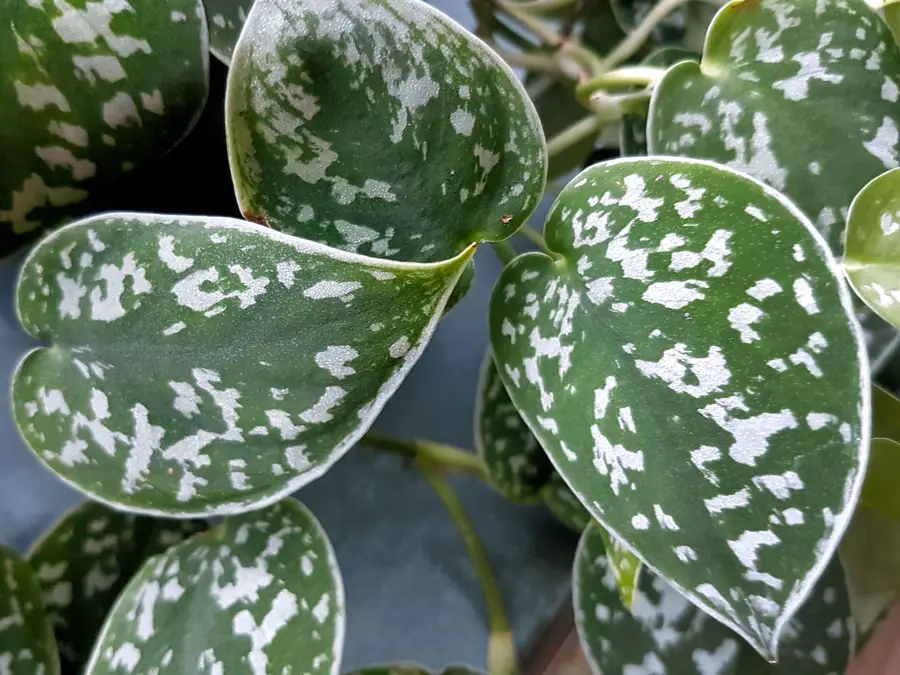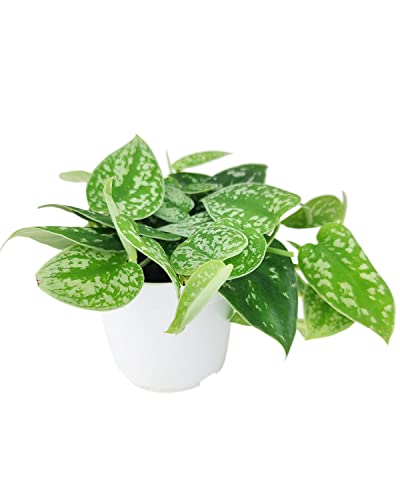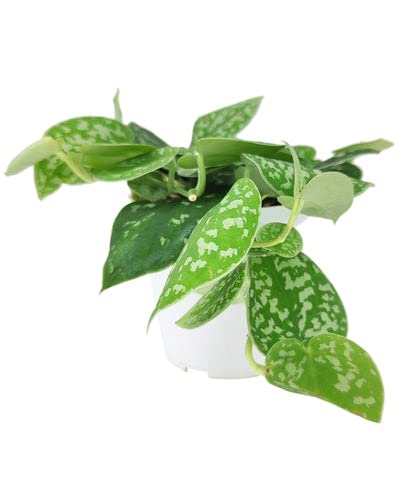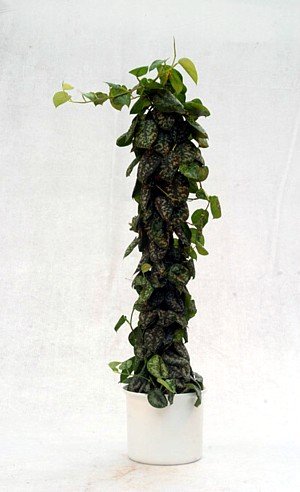This post contains affiliate links. If you buy something from one of our links we may earn a commission. Thanks

Discover Scindapsus pictus care tips and tricks in our easy-to-follow guide, and grow a thriving Satin Pothos that will enhance your indoor space!
Caring for Scindapsus pictus, also known as Satin Pothos, involves placing it in moderate to low indirect light and watering when the soil feels dry to the touch. Use well-draining potting mix and maintain indoor temperatures between 65-80°F. Fertilize with a balanced liquid fertilizer every 4-6 weeks during the growing season.
Are you looking to add a touch of elegance to your indoor space with a unique and eye-catching plant? Look no further!
Scindapsus pictus care is not only simple but also rewarding, as this evergreen climber boasts stunning matte green leaves with silver blotches.
In this comprehensive guide, we’ll share everything you need to know to grow a healthy and vibrant Satin Pothos that’s sure to be the envy of your friends and family. Let’s dive in!
An Introduction To Scindapsus pictus Care
Ready to embrace the world of Scindapsus pictus care and transform your indoor garden? We’ve got you covered!
In this all-inclusive guide, we’ll walk you through the fascinating origin and habitat of this beautiful evergreen climber, discuss its striking appearance, and provide expert advice on temperature, light, watering, and soil requirements.
Plus, we’ll share essential tips on pruning, propagation, and tackling common pests and diseases.
So, whether you’re a seasoned green thumb or a budding gardener, let’s embark on this exciting journey together and help your Satin Pothos flourish!
Meet the Scindapsus pictus (Satin Pothos)
Let’s start by getting acquainted with our star plant, the Scindapsus pictus.
Some common names are Satin Pothos, Silver Pothos, Silver Satin Pothos, and Silver Vine.
Actually, despite some of its common names, this plant is not a pothos
These captivating evergreen climbers are tropical plants with heart-shaped leaves and a wonderful addition to any indoor space, thanks to their attractive matte green leaves adorned with shimmery silver blotches.
A member of the Araceae family, the Scindapsus pictus is not only a beautiful houseplant but also relatively easy to care for, making it a popular choice among plant enthusiasts.
The Key to a Thriving Evergreen Climber
The secret to a healthy, thriving Scindapsus pictus lies in providing it with the right care.
When given the proper attention, this evergreen climber can grow up to 10 feet tall in its natural habitat, making a stunning statement piece in any room.
By understanding its specific needs in terms of light, temperature, watering, and soil, you can ensure your Satin Pothos flourishes and becomes a long-lasting, cherished part of your indoor garden.
What to Expect in This Blog Post
In this comprehensive guide, we’ll explore everything you need to know about Scindapsus pictus care.
We’ll delve into the plant’s origin and habitat, discuss its distinct appearance and characteristics, and provide practical advice on temperature, light, watering, soil, pruning, and propagation.
Additionally, we’ll tackle common pests and diseases that may affect your plant, and offer tips on prevention and treatment.
So, whether you’re a seasoned plant enthusiast or just starting your indoor gardening journey, this guide will equip you with the knowledge and confidence to care for your Scindapsus pictus like a pro!
Origin and Habitat
Embarking on the journey of Scindapsus pictus care begins with understanding its roots and natural habitat.
In this section, we’ll explore the exotic locales that this enchanting evergreen climber calls home.
From tropical forests to lush landscapes across Southeast Asia, the Satin Pothos’s unique adaptability and captivating beauty have charmed plant lovers around the world.
So, let’s dive in and uncover the fascinating origin story of this stunning houseplant, and see how this knowledge can help us create the perfect environment for it to thrive indoors!
Exploring the Native Regions
The Scindapsus pictus hails from a variety of exotic locations across Asia, including India, Bangladesh, Thailand, Peninsular Malaysia, Borneo, Java, Sumatra, Sulawesi, and the Philippines.
This diverse range of habitats has allowed the Satin Pothos to adapt and thrive in various environmental conditions, making it a resilient and versatile houseplant.
Growing in Open Ground and Climatic Conditions
In its natural habitat, the Scindapsus pictus can be found growing in open ground, often climbing trees and reaching heights of up to 10 feet.
This evergreen climber flourishes in the warm, humid climates typically found in its native regions, where it enjoys consistent temperatures and ample rainfall.
Unveiling the Scindapsus pictus ‘Argyraeus’ Cultivar
One of the most popular varieties of Scindapsus pictus is the ‘Argyraeus cultivar.
This stunning variant has gained the prestigious Royal Horticultural Society’s Award of Garden Merit, thanks to its exceptional beauty and ease of cultivation.
With its striking matte green leaves and delicate silver variegation, the ‘Argyraeus cultivar is a true showstopper in any indoor garden.
A Close Relative, but Not a Pothos
While the Scindapsus pictus is often referred to as Satin Pothos, it’s important to note that it is not a true pothos plant.
Although it shares a close relationship with the Pothos family, the Scindapsus pictus boasts its own unique characteristics that set it apart from its relatives.
This distinction makes the Satin Pothos a fascinating and distinctive addition to your indoor plant collection.
Appearance and Characteristics
Let’s take a closer look at the stunning appearance and unique characteristics of the Scindapsus pictus, which make it such a beloved addition to indoor gardens everywhere.
This section will delve into the plant’s eye-catching foliage, its climbing growth habit, and the meaning behind its Latin name.
By appreciating the visual appeal and distinctive features of this evergreen climber, you’ll undoubtedly fall in love with the Satin Pothos and be eager to provide it with the best care possible.
So, let’s dive into the captivating world of Scindapsus pictus and discover what makes it so special!
The Allure of Matte Green Leaves and Silver Blotches
One of the most striking features of the Scindapsus pictus is its distinctive foliage.
The plant boasts matte green leaves that are beautifully decorated with shimmering silver blotches, creating a stunning contrast.
These captivating patterns not only make the Satin Pothos a visual treat but also add a touch of elegance and charm to any indoor space.
The Adventurous Climbing Growth Habit
The Scindapsus pictus is known for its climbing growth habit, which allows it to reach impressive heights of up to 3 meters in open ground.
When grown indoors, you can encourage this adventurous climber to scale trellises, moss poles, or even walls, adding a vertical element to your indoor garden.
With its lush foliage and natural inclination to climb, the Satin Pothos can effortlessly transform any room into a verdant haven.
The “Painted” Beauty: Understanding the Latin Name
The Latin-specific epithet “pictus” has a unique relevance to the Scindapsus pictus. Meaning “painted,” the term perfectly captures the plant’s stunning silver variegation that appears to be meticulously hand-painted onto each leaf.
This artistic touch further enhances the plant’s visual appeal, making it a prized possession among houseplant enthusiasts who appreciate its intricate beauty.
Temperature, Humidity And Light Requirements
When it comes to caring for your Scindapsus pictus, temperature and light are two crucial factors that can greatly impact its growth and health.
Understanding the ideal temperature range and lighting conditions can help you provide the best possible environment for your Satin Pothos to thrive.
In this section, we’ll delve into Scindapsus pictus’ temperature and light requirements, discussing how to create the optimal conditions for a happy and healthy plant. Let’s get started!
Ideal Temperature Range: Finding the Sweet Spot
Scindapsus pictus is native to tropical regions, where it thrives in warm and humid environments.
As such, the ideal temperature range for this plant is between 65-80°F (15-27°C).
Temperatures below this range can cause growth to slow or even stop, while temperatures above can cause leaf scorch or other damage.
Consistency is Key: Maintaining the Right Temperature
While it’s important to provide the right temperature range, it’s equally crucial to maintain consistency.
Fluctuations in temperature can stress your Scindapsus pictus and make it more susceptible to pests and disease.
To keep the temperature steady, avoid placing your plant near drafty windows or doors, and try to maintain a constant temperature throughout the day and night.
Relative Humidity
Relative humidity refers to the amount of moisture present in the air compared to the maximum amount of moisture that the air can hold at a specific temperature.
It is expressed as a percentage and is an important factor in plant growth and health.
For Scindapsus pictus, which is native to tropical regions with high humidity, maintaining proper humidity levels is crucial to ensuring the plant’s health and growth.
Ideally, the relative humidity for Scindapsus pictus should be around 50-60%.
When the air is too dry, the plant can experience stunted growth, brown leaf tips, and increased susceptibility to pests and diseases.
On the other hand, when the air is too humid, the plant can be at risk of fungal growth and root rot.
Therefore, it’s important to monitor and maintain proper relative humidity levels for optimal growth and health of Scindapsus pictus.
Shedding Light on Scindapsus pictus Lighting Needs
In addition to temperature, lighting is also a crucial factor in Scindapsus pictus care.
As a tropical plant, it requires bright, indirect light to thrive. Direct sunlight can scorch the leaves, while too little light can cause slow growth and leggy stems.
To provide the right amount of light, place your Satin Pothos in a bright, well-lit area, but avoid placing it in direct sunlight.
If you notice your plant stretching toward the light or losing variegation, it may be a sign that it needs more light.
More on lighting requirements coming up later.
Watering and Soil Needs
Now that we’ve explored the enchanting world of Scindapsus pictus, let’s get down to the nitty-gritty of its care requirements.
In this section, we’ll discuss the watering and soil needs of this charming evergreen climber.
By using a well-balanced mix of coco coir and perlite, you’ll be able to create the perfect environment for your Satin Pothos to thrive.
So, whether you’re a seasoned plant enthusiast or just beginning your indoor gardening adventure, let’s learn the secrets to keeping your Scindapsus pictus happy, healthy, and well-hydrated with the ideal soil conditions!
Advantages of Using Coco Coir and Perlite
Opting for a mix of coco coir and perlite over traditional peat-based potting soil mixes has several benefits for your Scindapsus pictus.
Coco coir is an eco-friendly, sustainable alternative to peat moss, offering excellent moisture retention and aeration for your plant’s roots.
Perlite, on the other hand, improves drainage and helps prevent soil compaction, ensuring that your Satin Pothos has the optimal growing conditions to thrive.
This combination is perfect for supporting the overall health and growth of your Scindapsus pictus.
Mastering Watering Techniques for Satin Pothos
To keep your Scindapsus pictus healthy, it’s essential to learn the proper watering techniques.
Satin Pothos prefer to dry out slightly between waterings, so it’s best to water them when the top inch of the soil feels dry to the touch.
Don’t give your plants too much water and avoid soggy soil but when you do water make sure to water thoroughly, allowing the excess to drain out of the pot, and avoid letting the plant sit in standing water.
Consistent moisture levels will help your Scindapsus pictus flourish without succumbing to root rot.
Crafting the Ideal Soil Conditions
Creating suitable soil conditions is key to promoting healthy growth for your Satin Pothos.
Scindapsus pictus thrives in well-draining, nutrient-rich growing mediums that retain some moisture without becoming waterlogged.
A mix of coco coir and perlite will provide the perfect balance of airiness and moisture retention, setting the stage for a thriving plant.
Prioritizing Drainage and Preventing Overwatering
Good drainage is crucial for the well-being of your Scindapsus pictus, as it helps prevent overwatering and root rot.
Ensure your pot has drainage holes at the bottom to allow excess water to escape easily.
Keeping an eye on moisture levels and using a well-draining growing medium will go a long way in maintaining the health and vitality of your Satin Pothos.
Pruning and Propagation
As your Scindapsus pictus continues to grow and flourish, you’ll want to learn the art of pruning and propagation to keep it looking its best and even create new plants for your collection.
This section will discuss how to properly trim your Satin Pothos to maintain its shape and encourage bushier growth.
Additionally, we’ll explore the exciting process of propagating your Scindapsus pictus, so you can share the joy of this captivating plant with friends and family or expand your own indoor garden.
So, let’s dive into the world of pruning and propagation and discover how to keep your Satin Pothos thriving and multiplying!
Pruning Techniques: Maintaining Size and Shape
To keep your Scindapsus pictus looking its best, it’s essential to master the art of pruning.
Regularly trimming your Satin Pothos helps maintain its size and shape, prevents it from becoming too leggy, and encourages bushier growth.
Use clean, sharp scissors or pruning shears to snip off any overgrown or damaged stems just above a leaf node.
Remember to prune responsibly, never removing more than one-third of the plant at a time to avoid stressing it.
Propagation Methods for Scindapsus pictus
One of the most rewarding aspects of plant care is propagating your beloved Scindapsus pictus.
The most popular method of propagation for this plant is stem cuttings.
To propagate your Satin Pothos, simply take a healthy cutting with at least two to three leaves and a few aerial roots, if possible.
Make sure the cutting is from a healthy, well-established plant to increase the chances of successful propagation.
Tips for Successful Propagation
To ensure your Scindapsus pictus cuttings thrive, follow these simple tips for successful propagation:
• Place the cutting in a container with clean water, ensuring that the aerial roots or cut ends are submerged but the leaves remain above the waterline.
• Keep the container in a warm, bright spot with indirect sunlight to encourage root growth.
• Change the water regularly to prevent bacterial growth and keep the cutting healthy.
• Once the roots have grown to about an inch or two, you can transplant your cutting into a pot with a well-draining mix of coco coir and perlite.
With patience, care, and a little bit of luck, you’ll soon have new Scindapsus pictus plants to share or expand your own collection.
Lighting Requirements: Helping Your Scindapsus pictus Shine
Understanding the lighting requirements of your Scindapsus pictus is crucial for helping it thrive and maintain its stunning foliage.
In this section, we’ll discuss the ideal light conditions for your Satin Pothos, how to adjust for seasonal changes, and tips for keeping your plant happy and healthy, no matter where you place it in your home.
Ideal Light Conditions for Scindapsus pictus
The Scindapsus pictus thrives in bright, indirect light, which helps it maintain its vibrant foliage and steady growth.
Direct sunlight can scorch the delicate leaves, so it’s essential to provide filtered or diffused light for your Satin Pothos.
Ideal spots include near east or west-facing windows with sheer curtains, or a few feet away from a south-facing window.
Remember, too little light can cause the silver variegation to fade, so make sure your plant receives adequate light to keep its stunning appearance.
Adapting to Seasonal Changes in Lighting
As the seasons change, so does the quality and intensity of light in your home.
To keep your Scindapsus pictus happy year-round, it’s important to adapt to these changes.
During the darker winter months, consider moving your plant closer to a window or supplementing it with artificial light, such as LED grow lights, to maintain consistent light levels.
Conversely, during the brighter summer months, ensure your plant doesn’t receive too much direct sunlight, which could lead to sunburn or leaf scorch.
Tips for Optimizing Light Exposure in Your Home
To ensure your Scindapsus pictus gets the light it needs, consider these tips for optimizing light exposure in your home:
• Regularly rotate your plant to promote even growth and prevent it from becoming lopsided.
• Use mirrors or other reflective surfaces to bounce light into darker corners and help create a brighter environment for your Satin Pothos.
• Monitor the light throughout the day, as the intensity and angle of sunlight can change significantly. Adjust your plant’s position accordingly to maintain the ideal light conditions.
• Clean your windows regularly to maximize the amount of light entering your home, ensuring your Scindapsus pictus receives the brightness it needs to thrive.
Fertilizer Requirements: Nourishing Your Scindapsus pictus
Feeding your Scindapsus pictus with the right nutrients plays a vital role in promoting vibrant foliage and steady growth.
In this section, we’ll discuss the best types of fertilizers to use, the optimal feeding schedule, and tips to avoid over-fertilization, ensuring your Satin Pothos gets the nourishment it needs to thrive.
Choosing the Right Fertilizer for Scindapsus pictus
Selecting the appropriate fertilizer is essential for the well-being of your Scindapsus pictus.
A balanced, water-soluble fertilizer with equal parts nitrogen, phosphorus, and potassium (such as a 20-20-20 formula) is ideal for providing the necessary nutrients.
Organic options, like worm castings or liquid seaweed, can also be excellent choices for feeding your Satin Pothos.
Determining the Optimal Feeding Schedule
To ensure your Scindapsus pictus receives the right amount of nutrients, it’s crucial to establish a proper feeding schedule.
During the active growing season (spring and early summer), fertilize your Satin Pothos every 4-6 weeks, following the product’s instructions for the correct dosage.
In the fall and winter months, when growth slows down, you can reduce the frequency to once every 8-12 weeks or stop fertilizing altogether.
Tips to Avoid Over-Fertilization
Over-fertilizing your Scindapsus pictus can lead to various issues, such as root burn or excessive salt build-up.
To prevent these problems and keep your plant healthy, follow these tips:
• Always adhere to the recommended dosage on the fertilizer package, as using too much can harm your plant.
• Flush the soil with water every few months to help wash away excess salts and prevent build-up.
• Monitor your plant’s growth and overall health, adjusting the fertilization schedule if needed.
• Signs of over-fertilization may include yellow leaves, burnt leaf tips, or slow growth.
• If you suspect over-fertilization, temporarily stop feeding and flush the soil thoroughly with water to help remedy the issue.
Common Pests and Diseases
As a proud Scindapsus pictus caretaker, it’s essential to be prepared for potential pests and diseases that could affect your plant’s health.
In this section, we’ll explore common issues your Satin Pothos may encounter and discuss how to identify, prevent, and treat these problems.
With the right knowledge and a proactive approach, you can ensure your Scindapsus pictus stays happy, healthy, and pest-free.
So let’s dive in and learn how to tackle common pests and diseases like a pro!
While Scindapsus pictus is generally a hardy and resilient plant, it can still fall victim to certain pests and diseases.
Some of the most common culprits include spider mites, mealybugs, aphids, and scale insects.
Signs of an infestation may include yellowing or curling leaves, sticky residue, webbing, or the appearance of small, slow-moving insects on your plant.
Fungal diseases, such as root rot or leaf spot, can also affect your Satin Pothos, often caused by overwatering or poor air circulation.
Prevention and Treatment: Keeping Your Scindapsus pictus Healthy
To prevent and treat pests and diseases affecting your Scindapsus pictus, consider these methods:
• Regularly inspect your plant for signs of infestation or disease, and address issues as soon as possible.
• Maintain proper watering, lighting, and air circulation to keep your plant healthy and less susceptible to pests or diseases.
• For small infestations, you can manually remove pests with a soft cloth or cotton swab dipped in rubbing alcohol.
• Neem oil or insecticidal soap can be effective treatments for larger infestations. Be sure to follow the product instructions and apply as needed.
• For fungal diseases, adjust your watering schedule, improve air circulation, and trim away affected leaves or stems to prevent the spread. You may need to use a fungicide if an infection is severe.
Regular Care and Monitoring: A Key to Plant Health
By regularly caring for and monitoring your Scindapsus pictus, you can prevent most pests and diseases from gaining a foothold.
Paying close attention to your plant’s needs, promptly addressing any issues, and providing a clean, healthy environment will ensure your Satin Pothos continues to thrive and bring joy to your home.
Beating The Bugs
Spider mites, mealybugs, aphids, and scale insects are common pests that can affect a variety of houseplants, including Scindapsus pictus.
Neem oil and insecticidal soap are your best weapons for battling bugs. Always follow application directions.
Here’s a brief description of each:
Spider mites: These tiny, spider-like creatures are often red, brown, or yellow and can be challenging to see with the naked eye.
They feed on plant sap, causing leaves to turn yellow, dry out, and eventually fall off. You may notice fine webbing on the leaves and stems, which is a telltale sign of spider mite infestation.
Mealybugs: Mealybugs are small, oval-shaped insects covered in a white, powdery wax. They usually congregate in clusters on leaves, stems, and leaf joints.
Like spider mites, they feed on plant sap, leading to yellowing and wilting of the leaves. They also excrete a sticky substance called honeydew, which can attract other pests or lead to sooty mold.
Aphids: Aphids are small, soft-bodied insects that come in various colors, such as green, black, or yellow.
They also feed on plant sap, often causing leaves to curl or become distorted. Aphids excrete honeydew, similar to mealybugs, leading to potential sooty mold growth or attracting other pests.
Scale insects: Scale insects are small, round or oval-shaped pests that have a protective shell-like covering. They can be brown, tan, or black and attach themselves to plant stems or leaves.
They feed on plant sap, leading to yellowing or wilting leaves and stunted growth. Like mealybugs and aphids, scale insects excrete honeydew, leading to sooty mold or attracting other pests.
Repotting
Are you a proud owner of a Scindapsus pictus plant that has been with you for a while?
As your plant grows and matures, it may eventually outgrow its pot, leading to stunted growth, root-bound conditions, or other problems.
This is where repotting comes in! In this section, we’ll explore when and how to repot your Scindapsus pictus to keep it happy and healthy.
We’ll cover the signs that indicate it’s time to repot, the ideal pot size and type, and step-by-step instructions on how to repot your plant.
Plus, we’ll share some tips for aftercare to help your newly repotted Scindapsus pictus thrive. Let’s get started!
When and How to Repot Scindapsus Pictus
Repotting is an essential part of caring for your Scindapsus pictus plant.
It’s important to know when to repot and how to do it properly to promote healthy growth and prevent the plant from becoming root-bound.
In this section, we’ll discuss the signs that indicate it’s time to repot, the ideal pot size and type for your plant, and how to repot without causing undue stress.
Signs that Indicate It’s Time to Repot
Root-bound plant: If you notice that the roots of your Scindapsus pictus are growing out of the drainage holes, it’s a sure sign that the plant needs a larger pot.
Slow or stunted growth: If your plant seems to be growing slower than usual or appears stunted, it may be a sign that the roots are constricted and need more space to grow.
Poor drainage or waterlogged soil: If you notice that water is sitting in the soil and not draining properly, it may be a sign that the plant’s roots are starting to rot, and repotting is necessary to prevent further damage.
Ideal Pot Size and Type for Scindapsus Pictus
Choosing the right pot size: When selecting a new pot for your Scindapsus pictus, choose a size that’s 1-2 inches larger in diameter than the current pot.
This will give the roots room to grow without overwhelming the plant.
Benefits of terracotta or ceramic pots: These types of pots are porous and allow for better drainage and aeration of the soil, which can promote healthy root growth.
Avoid plastic pots for better drainage: Plastic pots are non-porous and may trap water in the soil, leading to overwatering and root rot.
How to Repot Scindapsus Pictus
Steps for repotting a Scindapsus pictus:
• Carefully remove the plant from its current pot, gently loosen any tangled roots and trim off dead or mushy roots.
• Place the plant in the new pot, and add fresh soil around the roots making sure it is planted at the same level it was growing before.
• Gently pat the soil down as you add it around the roots and leave an inch below the pot lip to make watering easy.
• After the soil is in place water thoroughly to eliminate any air pockets in the soil.
Tips for minimizing stress on the plant: Water the plant a few days before repotting to help the soil stick together and minimize root damage during the process.
Aftercare Tips for Newly Repotted Plants
Watering and fertilizing after repotting: Give the plant a thorough watering immediately after repotting and then wait until the top inch of soil dries out before watering again.
You may also want to add a diluted fertilizer solution to the soil to promote healthy growth.
Monitoring for signs of stress or shock: Keep an eye on the plant for the first few weeks after repotting to ensure it’s adjusting well to its new environment.
Tips for helping the plant acclimate to its new pot: Place the plant in a shaded area for a few days after repotting to reduce stress and then gradually move it back to its normal location.
Winter Care
Winter can be a challenging time for indoor plants, especially tropical ones like Scindapsus pictus.
It’s important to adjust your care routine to account for the colder temperatures, dry air and lower light levels.
In this section, we’ll cover everything you need to know about keeping your Scindapsus pictus happy and healthy during the winter months.
From adjusting your watering schedule to providing adequate light, we’ll explore the best strategies for maintaining your plant’s well-being. So, let’s dive in!
Keeping Scindapsus Pictus Happy During the Colder Months
As temperatures drop and the days grow shorter, caring for houseplants can become a bit more challenging.
Scindapsus pictus, like many plants, requires specific care during the winter months to thrive.
In this section, we’ll cover how to keep your Scindapsus pictus happy during the colder months, including adjusting watering frequency, maintaining humidity levels, providing adequate light, and addressing common winter issues.
Adjusting Watering Frequency for Winter Months
As the temperature drops, your Scindapsus pictus water requirements will also decrease.
It’s important to adjust your watering frequency to prevent overwatering, which can lead to root rot.
Check the soil regularly and only water when the top inch is dry to the touch.
Consider using a moisture meter to accurately gauge the plant’s moisture needs. Avoid overwatering, as this can lead to waterlogged soil, which can contribute to root rot.
Maintaining Humidity Levels in Winter
Dry winter air can be tough on houseplants, but Scindapsus pictus in particular prefers a more humid environment.
To maintain humidity levels around the plant, consider using a humidifier, placing a tray of water near the plant, or using a pebble tray.
Misting the plant can also help increase humidity, but be careful not to overdo it as wet leaves can cause spotting or fungal growth.
Providing Adequate Light for Scindapsus Pictus in Winter
As the days get shorter, your Scindapsus pictus may receive less natural light.
If possible, move the plant to a brighter location, such as a south-facing window.
If natural light is limited, consider supplementing with artificial light.
LED grow lights are a great option and can be set on a timer to provide consistent light for your plant.
Common Winter Issues and How to Address Them
During the winter months, Scindapsus pictus may experience issues such as leaf drop, pests, or fungal growth.
Keep an eye on the plant and address any issues promptly.
If you notice yellowing leaves, adjust your watering frequency or consider adding fertilizer to provide the necessary nutrients.
If pests such as spider mites or mealybugs appear, use a gentle insecticidal soap to eradicate them.
Fungal growth can be prevented by ensuring proper drainage and avoiding overwatering.
Toxicity
As much as we enjoy the beauty of our houseplants, it’s important to remember that some of them can be toxic to our furry friends and little ones.
Scindapsus pictus, with its gorgeous variegated leaves, is no exception.
In this section, we’ll go over the potential dangers of Scindapsus pictus, including how to recognize symptoms of ingestion and ways to prevent accidental ingestion.
We’ll also provide tips on how to handle and care for your Scindapsus pictus safely and keep your loved ones out of harm’s way. Let’s get started!
Introduction: Understanding Scindapsus Pictus’ Toxicity
As a pet parent or a parent of young children, it is important to ensure the safety of your loved ones around houseplants.
Scindapsus Pictus, while a beautiful plant, can be potentially harmful if ingested by pets or children.
In this section, we will discuss the potential risks associated with Scindapsus Pictus and how you can keep your family and furry friends safe.
Overview of Scindapsus Pictus’ Toxicity to Pets and Humans
Scindapsus Pictus contains calcium oxalate crystals, which can cause irritation and swelling of the mouth and throat if ingested.
These crystals can also cause skin irritation and allergic reactions in sensitive individuals.
Importance of Keeping the Plant Away from Pets and Children
It is important to keep Scindapsus Pictus out of reach of pets and children who may be tempted to chew on the leaves.
Consider placing the plant in a hanging basket or on a high shelf to prevent access.
Potential Risks to Pets and Children
Symptoms of Ingestion and Potential Health Risks
Ingesting Scindapsus Pictus can cause mouth and throat irritation, swelling, and difficulty breathing, as well as skin irritation and rash.
Ways to Prevent Accidental Ingestion
Educate children and pets about the dangers of eating or chewing on houseplants, and keep the plant in a secure location out of reach.
You may also consider using a bitter-tasting deterrent spray on the leaves to discourage chewing.
Tips for Keeping Your Scindapsus Pictus and Loved Ones Safe
Best Practices for Handling and Caring for Scindapsus Pictus:
Wear gloves when handling the plant to avoid skin irritation, and wash your hands thoroughly after handling.
Monitor the plant regularly for signs of damage or pests.
Strategies for Keeping Pets and Children Safe Around the Plant
Aside from keeping the plant out of reach, you can also use physical barriers or deterrents to prevent access.
Additionally, keep your pet’s food and water dishes away from the plant to avoid any accidental ingestion.
Troubleshooting Common Issues
Let’s face it, sometimes even the most well-cared-for Scindapsus pictus can encounter problems.
Whether it’s yellowing leaves or drooping stems, it can be frustrating to see your beloved plant suffering.
Fortunately, many common issues can be addressed with a bit of know-how.
In this section, we’ll explore some of the most common problems that Scindapsus pictus owners might encounter and offer solutions to help get your plant back on track. Let’s dive in!
Addressing Common Problems with Scindapsus Pictus
Scindapsus pictus is a stunning houseplant that can enhance the beauty of any indoor space.
However, even the most experienced plant owners can face some challenges in keeping it healthy and happy.
In this section, we’ll explore some common problems you might encounter when caring for your Scindapsus pictus and discuss how to fix them.
Yellowing Leaves and What They Mean
Yellowing leaves are a common issue that Scindapsus pictus owners face.
The causes can vary, but some of the most common ones are nutrient deficiencies, overwatering, or exposure to direct sunlight.
If you notice yellowing leaves on your Scindapsus pictus, it’s crucial to take prompt action to avoid further damage.
To address this problem, you can start by adjusting your watering schedule, providing proper nutrition, and ensuring the plant is not exposed to direct sunlight.
Drooping or Wilting Leaves: Causes and Solutions
If your Scindapsus pictus leaves start drooping or wilting, it’s a sign that the plant is not getting enough water or suffering from root rot.
This problem can be caused by overwatering or underwatering, depending on the situation.
To fix this issue, you need to identify the root cause and adjust your watering schedule accordingly.
If the problem is root rot, you may need to repot the plant and remove the damaged roots.
Loss of Variegation: What to Do
Variegation is one of the most attractive features of Scindapsus pictus, so it can be disheartening to see it fade away.
If you notice your plant’s leaves losing their variegation, it’s a sign that the plant is not receiving enough light.
To fix this issue, you can move the plant to a brighter location or provide artificial light.
In some cases, the loss of variegation could be a sign of nutrient deficiency, so it’s important to monitor the plant’s overall health.
Scindapsus Pictus Varieties
Are you a fan of Scindapsus pictus and want to learn more about the different cultivars or varieties available?
In this section, we will explore some of the most popular Scindapsus pictus varieties and highlight their unique features and care requirements.
From the classic Scindapsus pictus ‘Argyraeus’ to the lesser-known ‘Satin Pothos,’ you’ll discover a variety that suits your style and preferences.
Let’s dive in and explore the exciting world of Scindapsus pictus varieties!
Exploring Different Varieties of Scindapsus Pictus
Scindapsus pictus is a popular and widely loved houseplant due to its striking foliage and easy-care requirements.
However, did you know that there are different cultivars and varieties of this plant, each with its own unique characteristics and care requirements?
In this section, we’ll take a closer look at some of the most popular varieties of Scindapsus pictus and share tips for their care and maintenance.
Scindapsus Pictus Argyraeus
Scindapsus Pictus Argyraeus, also known as satin pothos, is a popular variety characterized by its striking silver-grey foliage with green markings.
This variety thrives in bright, indirect light and moderate to high humidity.
It’s best to keep the soil slightly moist, but not waterlogged, and to fertilize during the growing season.
To propagate, take stem cuttings and root them in water or soil.
Scindapsus Pictus ‘Exotica’
Scindapsus Pictus ‘Exotica’ is another popular variety, prized for its elongated, heart-shaped leaves with silver markings.
This plant prefers bright, indirect light and moderate humidity levels.
It’s important to keep the soil moist but not waterlogged and to fertilize during the growing season.
To propagate, take stem cuttings and root them in water or soil.
Other Varieties of Scindapsus Pictus
There are other popular varieties of Scindapsus pictus, including ‘Trebie,’ ‘Silvery Ann,’ and ‘Jade.’
‘Trebie’ has smaller leaves with silver spots, while ‘Silvery Ann’ has larger leaves with silver markings.
‘Jade’ has vibrant green leaves with silver markings. Each variety has its own unique features and care requirements, so be sure to research and select the one that best fits your needs and care abilities.
FAQ: Answering Common Scindapsus pictus Questions
Q: Is Scindapsus pictus low light?
A: Scindapsus pictus can tolerate low light conditions, but it prefers bright, indirect light to maintain its vibrant foliage and healthy growth.
Too little light can cause the silver variegation to fade, so it’s best to place your plant in a well-lit area with filtered or diffused sunlight.
Q: Do Scindapsus like to be misted?
A: Scindapsus pictus appreciates higher humidity levels, and misting can help maintain the moisture around the plant. However, make sure not to overdo it, as excessive moisture on the leaves can lead to fungal diseases.
You can also increase humidity by using a humidifier, placing a tray of water near the plant, or grouping it with other humidity-loving plants.
Q: Are Scindapsus pictus slow-growing?
A: Scindapsus pictus has a moderate growth rate, especially when provided with the right care, including adequate light, water, and nutrients.
The plant’s growth may slow down during the cooler months but will typically pick up again in the spring and summer.
Q: How often do you water Scindapsus?
A: Watering frequency for Scindapsus pictus depends on various factors, such as the potting medium, temperature, and humidity.
Generally, it’s best to water your plant when the top inch of the soil feels dry to the touch.
Overwatering can lead to root rot, so ensure proper drainage and avoid letting your plant sit in standing water.
Q: Do Scindapsus like to climb or hang?
A: Scindapsus pictus is a natural climber in its native habitat, but it can also be grown as a hanging plant in indoor settings.
Providing a support structure like a moss pole or trellis will allow your Scindapsus to climb, promoting a more vertical growth habit.
Alternatively, you can let the plant’s trailing vines hang for a beautiful cascading effect.
Q: Is Scindapsus pictus hanging or climbing?
A: Scindapsus pictus can be grown as either a hanging or climbing plant, depending on your preference and available space.
By providing a support structure, you can encourage your Scindapsus to climb, or you can simply let the vines hang naturally for an attractive, cascading display.
Scindapsus pictus Care Final Thoughts
As we wrap up our in-depth exploration of Scindapsus pictus care, we hope you’ve found the information and tips helpful for nurturing your own Satin Pothos.
With a little bit of attention and the right care practices, you can enjoy the beauty and charm of this stunning evergreen climber for years to come.
Remember, the key to a happy and healthy Scindapsus pictus is understanding its needs and providing a supportive environment. Happy growing, and may your Scindapsus pictus flourish and thrive!
Scindapsus pictus Care Recap: Key Takeaways
In this comprehensive guide, we’ve discussed various aspects of Scindapsus pictus care, including its origin and habitat, distinctive appearance, and essential care requirements such as light, water, soil, pruning, propagation, pest management, and more.
Remember, providing the right balance of light, water, humidity, and nutrients will ensure a thriving, vibrant Satin Pothos.
Growing Scindapsus pictus: A Rewarding Experience
Caring for a Scindapsus pictus is a rewarding experience, as its stunning foliage and easy-to-care-for nature make it an excellent addition to any home.
With a little bit of attention and proper care, you’ll be able to enjoy the beauty and charm of this evergreen climber for years to come.
Read more: Benefits Of Keeping Indoor Plants





















